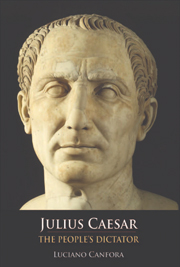Book contents
- Frontmatter
- Contents
- Translators' Note
- Acknowledgements
- Foreword
- PART I FROM SULLA TO CATILINE
- PART II FROM THE TRIUMVIRATE TO THE CONQUEST OF GAUL
- PART III THE LONG CIVIL WAR
- 16 Towards the Crisis
- 17 Striving after Tyranny?
- 18 Attacking the World with Five Cohorts
- 19 Caesar's ‘Programme’: In Search of Consensus
- 20 ‘Amicitia’
- 21 From the Rubicon to Pharsalus
- 22 Against Subversion
- 23 Alexandria
- 24 Caesar Saved by the Jews
- 25 From Syria to Zela
- 26 The Long Civil War
- 27 The Shoot of a Palm Tree: The Young Octavius Emerges
- 28 ‘Anticato’
- PART IV FROM THE CONSPIRACY TO THE TRIUMPH OF CAESARISM
- Chronology
- Bibliography
- Index
27 - The Shoot of a Palm Tree: The Young Octavius Emerges
from PART III - THE LONG CIVIL WAR
Published online by Cambridge University Press: 05 August 2013
- Frontmatter
- Contents
- Translators' Note
- Acknowledgements
- Foreword
- PART I FROM SULLA TO CATILINE
- PART II FROM THE TRIUMVIRATE TO THE CONQUEST OF GAUL
- PART III THE LONG CIVIL WAR
- 16 Towards the Crisis
- 17 Striving after Tyranny?
- 18 Attacking the World with Five Cohorts
- 19 Caesar's ‘Programme’: In Search of Consensus
- 20 ‘Amicitia’
- 21 From the Rubicon to Pharsalus
- 22 Against Subversion
- 23 Alexandria
- 24 Caesar Saved by the Jews
- 25 From Syria to Zela
- 26 The Long Civil War
- 27 The Shoot of a Palm Tree: The Young Octavius Emerges
- 28 ‘Anticato’
- PART IV FROM THE CONSPIRACY TO THE TRIUMPH OF CAESARISM
- Chronology
- Bibliography
- Index
Summary
Octavius, the future Augustus, was the son of a certain Octavius (of an equestrian family, of Velitrae/Velletri) and Atia. Atia was the daughter of Marcus Atius Balbus of Aricia, who had married Caesar's sister, Julia, and perhaps because of this he had forged ahead in his public career, attaining the praetorship. The kinship, then, between Octavius and Caesar was not close. Sources like Dio Cassius who describe Octavius (the later Octavian) as the son of a sister of Caesar (43.41.3) simplify too much, or are lying in order to bring Octavius and Caesar closer together, like the historical myth-maker Nicolaus of Damascus, who declared, ‘Octavian was Caesar's closest relative.’
Sextus Caesar, as we know, was a much closer blood-relation to the dictator. He was a son of the Julian family, Octavius was not. Octavius was adopted into the Julian family, becoming Gaius Julius Caesar Octavianus.
Sextus Caesar, however, described by the author of the Alexandrian War as ‘a friend and relation’ of Caesar, was removed from the political scene by his unexpected death. This happened, as we know, in the summer of 46 bc, when Caesar's men were appealing to him to make haste to Further Spain, where the rebellion fomented by Pompey's sons was spreading alarmingly with every passing day. In that summer of 46 Caesar found himself once again facing the need to make rapid and difficult choices between the rebellion in Syria and the rebellion in Spain.
- Type
- Chapter
- Information
- Julius CaesarThe People's Dictator, pp. 245 - 255Publisher: Edinburgh University PressPrint publication year: 2007



